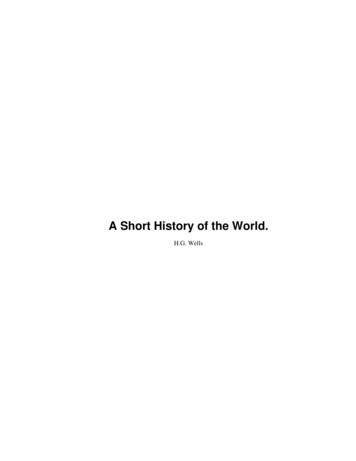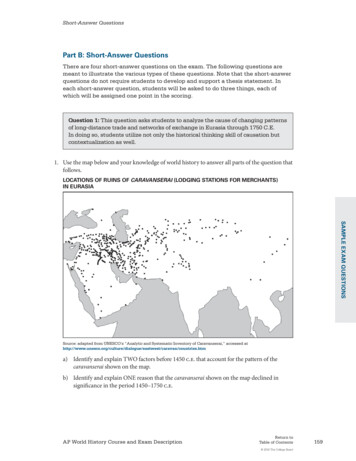
Transcription
A Short History of the World.H.G. Wells
A Short History of the World.Table of ContentsA Short History of the World.1H.G. Wells.1I. The World in Space.2II. The World in Time.3III. The Beginnings of Life.4IV. The Age of Fishes.5V. The Age of the Coal Swamps.7VI. The Age of Reptiles.9VII. The First Birds and the First Mammals.10VIII. The Age of Mammals.12IX. Monkeys, Apes and Sub men.13X. The Neanderthaler and the Rhodesian Man.15XI. The First True Men.16XII. Primitive Thought.18XIII. The Beginnings of Cultivation.20XIV. Primitive Neolithic Civilizations.22XV. Sumeria, Early Egypt and Writing.23XVI. Primitive Nomadic Peoples.25XVII. The First Sea going Peoples.26XVIII. Egypt, Babylon and Assyria.28XIX. The Primitive Aryans.31XX. The Last Babylonian Empire and the Empire of Darius I.33XXI. The Early History of the Jews.34XXII. Priests and Prophets in Judea.36XXIII. The Greeks.38XXIV. The Wars of the Greeks and Persians.40XXV. The Splendour of Greece.41XXVI. The Empire of Alexander the Great.42XXVII. The Museum and Library at Alexandria.44XXVIII. The Life of Gautama Buddha.46XXIX. King Asoka.48XXX. Confucius and Lao Tse.49XXXI. Rome Comes into History.51XXXII. Rome and Carthage.53XXXIII. The Growth of the Roman Empire.54XXXIV. Between Rome and China.59XXXV. The Common Man's Life under the Early Roman Empire.60XXXVI. Religious Developments under the Roman Empire.63XXXVII. The Teaching of Jesus.65XXXVIII. The Development of Doctrinal Christianity.67XXXIX. The Barbarians Break the Empire into East and West.69XL. The Huns and the End of the Western Empire.70XLI. The Byzantine and Sassanid Empires.72XLII. The Dynasties of Suy and Tang in China.74XLIII. Muhammad and Islam.75XLIV. The Great Days of the Arabs.76XLV. The Development of Latin Christendom.78XLVI. The Crusades and the Age of Papal Dominion.81i
A Short History of the World.Table of ContentsA Short History of the World.XLVII. Recalcitrant Princes and the Great Schism.85XLVIII. The Mongol Conquests.88XLIX. The Intellectual Revival of the Europeans.90L. The Reformation of the Latin Church.93LI. The Emperor Charles V.95LII. The Age of Political Experiments; of Grand Monarchy and Parliaments and Republicanism inEurope.98LIII. The New Empires of the Europeans in Asia and Overseas.102LIV. The American War of Independence.104LV. The French Revolution and the Restoration of Monarchy in France.106LVI. The Uneasy Peace in Europe That Followed the Fall of Napoleon.109LVII. The Development of Material Knowledge.111LVIII. The Industrial Revolution.115LIX. The Development of Modern Political and Social Ideas.116LX. The Expansion of the United States.121LXI. The Rise of Germany to Predominance in Europe.124LXII. The New Overseas Empires of Steamship and Railway.125LXIII. European Aggression in Asia, and the Rise of Japan.127LXIV. The British Empire in 1914.129LXV. The Age of Armament in Europe, and the Great War of 1914 18.130LXVI. The Revolution and Famine in Russia.132LXVII. The Political and Social Reconstruction of the World.134ii
A Short History of the World.H.G. WellsThis page copyright 2002 Blackmask Online.http://www.blackmask.com I. The World in Space II. The World in Time III. The Beginnings of Life IV. The Age of Fishes V. The Age of the Coal Swamps VI. The Age of Reptiles VII. The First Birds and the First Mammals VIII. The Age of Mammals IX. Monkeys, Apes and Sub men X. The Neanderthaler and the Rhodesian Man XI. The First True Men XII. Primitive Thought XIII. The Beginnings of Cultivation XIV. Primitive Neolithic Civilizations XV. Sumeria, Early Egypt and Writing XVI. Primitive Nomadic Peoples XVII. The First Sea going Peoples XVIII. Egypt, Babylon and Assyria XIX. The Primitive Aryans XX. The Last Babylonian Empire and the Empire of Darius I XXI. The Early History of the Jews XXII. Priests and Prophets in Judea XXIII. The Greeks XXIV. The Wars of the Greeks and Persians XXV. The Splendour of Greece XXVI. The Empire of Alexander the Great XXVII. The Museum and Library at Alexandria XXVIII. The Life of Gautama Buddha XXIX. King Asoka XXX. Confucius and Lao Tse XXXI. Rome Comes into History XXXII. Rome and Carthage XXXIII. The Growth of the Roman Empire XXXIV. Between Rome and China XXXV. The Common Man's Life under the Early Roman Empire XXXVI. Religious Developments under the Roman Empire XXXVII. The Teaching of Jesus XXXVIII. The Development of Doctrinal Christianity XXXIX. The Barbarians Break the Empire into East and West XL. The Huns and the End of the Western Empire XLI. The Byzantine and Sassanid Empires XLII. The Dynasties of Suy and Tang in ChinaA Short History of the World.1
A Short History of the World. XLIII. Muhammad and Islam XLIV. The Great Days of the Arabs XLV. The Development of Latin Christendom XLVI. The Crusades and the Age of Papal Dominion XLVII. Recalcitrant Princes and the Great Schism XLVIII. The Mongol Conquests XLIX. The Intellectual Revival of the Europeans L. The Reformation of the Latin Church LI. The Emperor Charles V LII. The Age of Political Experiments; of Grand Monarchy and Parliaments and Republicanism in Europe LIII. The New Empires of the Europeans in Asia and Overseas LIV. The American War of Independence LV. The French Revolution and the Restoration of Monarchy in France LVI. The Uneasy Peace in Europe That Followed the Fall of Napoleon LVII. The Development of Material Knowledge LVIII. The Industrial Revolution LIX. The Development of Modern Political and Social Ideas LX. The Expansion of the United States LXI. The Rise of Germany to Predominance in Europe LXII. The New Overseas Empires of Steamship and Railway LXIII. European Aggression in Asia, and the Rise of Japan LXIV. The British Empire in 1914 LXV. The Age of Armament in Europe, and the Great War of 1914 18 LXVI. The Revolution and Famine in Russia LXVII. The Political and Social Reconstruction of the WorldI. The World in SpaceTHE STORY of our world is a story that is still very imperfectly known. A couple of hundred years ago menpossessed the history of little more than the last three thousand years. What happened before that time was amatter of legend and speculation. Over a large part of the civilized world it was believed and taught that the worldhad been created suddenly in 4004 B.C., though authorities differed as to whether this had occurred in the springor autumn of that year. This fantastically precise misconception was based upon a too literal interpretation of theHebrew Bible, and upon rather arbitrary theological assumptions connected therewith. Such ideas have long sincebeen abandoned by religious teachers, and it is universally recognized that the universe in which we live has to allappearances existed for an enormous period of time and possibly for endless time. Of course there may bedeception in these appearances, as a room may be made to seem endless by putting mirrors facing each other ateither end. But that the universe in which we live has existed only for six or seven thousand years may beregarded as an altogether exploded idea.The earth, as everybody knows nowadays, is a spheroid, a sphere slightly compressed, orange fashion, with adiameter of nearly 8,000 miles. Its spherical shape has been known at least to a limited number of intelligentpeople for nearly 2,500 years, but before that time it was supposed to be flat, and various ideas which now seemfantastic were entertained about its relations to the sky and the stars and planets. We know now that it rotatesupon its axis (which is about 24 miles shorter than its equatorial diameter) every twenty four hours, and that thisis the cause of the alternations of day and night, that it circles about the sun in a slightly distorted and slowlyvariable oval path in a year. Its distance from the sun varies between ninety one and a half millions at its nearestand ninety four and a half million miles.About the earth circles a smaller sphere, the moon, at an average distance of 239,000 miles. Earth and moon areI. The World in Space2
A Short History of the World.not the only bodies to travel round the sun. There are also the planets, Mercury and Venus, at distances ofthirty six and sixty seven millions of miles; and beyond the circle of the earth and disregarding a belt ofnumerous smaller bodies, the planetoids, there are Mars, Jupiter, Saturn, Uranus and Neptune at mean distances of141, 483, 886, 1,782, and 1,793 millions of miles respectively. These figures in millions of miles are very difficultfor the mind to grasp. It may help the reader's imagination if we reduce the sun and planets to a smaller, moreconceivable scale.If, then, we represent our earth as a little ball of one inch diameter, the sun would be a big globe nine feet acrossand 323 yards away, that is about a fifth of a mile, four or five minutes' walking. The moon would be a small peatwo feet and a half from the world. Between earth and sun there would be the two inner planets, Mercury andVenus, at distances of one hundred and twenty five and two hundred and fifty yards from the sun. All round andabout these bodies there would be emptiness until you came to Mars, a hundred and seventy five feet beyond theearth; Jupiter nearly a mile away, a foot in diameter; Saturn, a little smaller, two miles off; Uranus four miles offand Neptune six miles off. Then nothingness and nothingness except for small particles and drifting scraps ofattenuated vapour for thousands of miles. The nearest star to earth on this scale would be 40,000 miles away.These figures will serve perhaps to give one some conception of the immense emptiness of space in which thedrama of life goes on.For in all this enormous vacancy of space we know certainly of life only upon the surface of our earth. It does notpenetrate much more than three miles down into the 4,000 miles that separate us from the centre of our globe, andit does not reach more than five miles above its surface. Apparently all the limitlessness of space is otherwiseempty and dead.The deepest ocean dredgings go down to five miles. The highest recorded flight of an aeroplane is little more thanfour miles. Men have reached to seven miles up in balloons, but at a cost of great suffering. No bird can fly sohigh as five miles, and small birds and insects which have been carried up by aeroplanes drop off insensible farbelow that level.II. The World in TimeIN the last fifty years there has been much very fine and interesting speculation on the part of scientific men uponthe age and origin of our earth. Here we cannot pretend to give even a summary of such speculations because theyinvolve the most subtle mathematical and physical considerations. The truth is that the physical and astronomicalsciences are still too undeveloped as yet to make anything of the sort more than an illustrative guesswork. Thegeneral tendency has been to make the estimated age of our globe longer and longer. It now seems probable thatthe earth has had an independent existence as a spinning planet flying round and round the sun for a longer periodthan 2,000,000,000 years. It may have been much longer than that. This is a length of time that absolutelyoverpowers the imagination.Before that vast period of separate existence, the sun and earth and the other planets that circulate round the sunmay have been a great swirl of diffused matter in space. The telescope reveals to us in various parts of theheavens luminous spiral clouds of matter, the spiral nebulae, which appear to be in rotation about a centre. It issupposed by many astronomers that the sun and its planets were once such a spiral, and that their matter hasundergone concentration into its present form. Through majestic aeons that concentration went on until in thatvast remoteness of the past for which we have given figures, the world and its moon were distinguishable. Theywere spinning then much faster than they are spinning now; they were at a lesser distance from the sun; theytravelled round it very much faster, and they were probably incandescent or molten at the surface. The sun itselfwas a much greater blaze in the heavens.II. The World in Time3
A Short History of the World.If we could go back through that infinitude of time and see the earth in this earlier stage of its history, we shouldbehold a scene more like the interior of a blast furnace or the surface of a lava flow before it cools and cakes overthan any other contemporary scene. No water would be visible because all the water there was would still besuperheated steam in a stormy atmosphere of sulphurous and metallic vapours. Beneath this would swirl and boilan ocean of molten rock substance. Across a sky of fiery clouds the glare of the hurrying sun and moon wouldsweep swiftly like hot breaths of flame.Slowly by degrees as one million of years followed another, this fiery scene would lose its eruptiveincandescence. The vapours in the sky would rain down and become less dense overhead; great slaggy cakes ofsolidifying rock would appear upon the surface of the molten sea, and sink under it, to be replaced by otherfloating masses. The sun and moon growing now each more distant and each smaller, would rush withdiminishing swiftness across the heavens. The moon now, because of its smaller size, would be already cooled farbelow incandescence, and would be alternately obstructing and reflecting the sunlight in a series of eclipses andfull moons.And so with a tremendous slowness through the vastness of time, the earth would grow more and more like theearth on which we live, until at last an age would come when, in the cooling air, steam would begin to condenseinto clouds, and the first rain would fall hissing upon the first rocks below. For endless millenia the greater part ofthe earth's water would still be vaporized in the atmosphere, but there would now be hot streams running over thecrystallizing rocks below and pools and lakes into which these streams would be carrying detritus and depositingsediment.At last a condition of things must have been attained in which a man might have stood up on earth and lookedabout him and lived. If we could have visited the earth at that time we should have stood on great lava likemasses of rock without a trace of soil or touch of living vegetation, under a storm rent sky. Hot and violentwinds, exceeding the fiercest tornado that ever blows, and downpours of rain such as our milder, slower earthto day knows nothing of, might have assailed us. The water of the downpour would have rushed by us, muddywith the spoils of the rocks, coming together into torrents, cutting deep gorges and canyons as they hurried past todeposit their sediment in the earliest seas. Through the clouds we should have glimpsed a great sun movingvisibly across the sky, and in its wake and in the wake of the moon would have come a diurnal tide of earthquakeand upheaval. And the moon, which nowadays keeps one constant face to earth, would then have been rotatingvisibly and showing the side it now hides so inexorably.The earth aged. One million years followed another, and the day lengthened, the sun grew more distant andmilder, the moon's pace in the sky slackened; the intensity of rain and storm diminished and the water in the firstseas increased and ran together into the ocean garment our planet henceforth wore.But there was no life as yet upon the earth; the seas were lifeless, and the rocks were barren.III. The Beginnings of LifeAS everybody knows nowadays, the knowledge we possess of life before the beginnings of human memory andtradition is derived from the markings and fossils of living things in the stratified rocks. We find preserved inshale and slate, limestone, and sandstone, bones, shells, fibres, stems, fruits, footmarks, scratchings and the like,side by side with the ripple marks of the earliest tides and the pittings of the earliest rain falls. It is by thesedulous examination of this Record of the Rocks that the past history of the earth's life has been pieced together.That much nearly everybody knows to day. The sedimentary rocks do not lie neatly stratum above stratum; theyhave been crumpled, bent, thrust about, distorted and mixed together like the leaves of a library that has beenrepeatedly looted and burnt, and it is only as a result of many devoted lifetimes of work that the record has beenput into order and read. The whole compass of time represented by the record of the rocks is now estimated asIII. The Beginnings of Life4
A Short History of the World.1,600,000,000 years.The earliest rocks in the record are called by geologists the Azoic rocks, because they show no traces of life.Great areas of these Azoic rocks lie uncovered in North America, and they are of such a thickness that geologistsconsider that they represent a period of at least half of the 1,600,000,000 which they assign to the wholegeological record. Let me repeat this profoundly significant fact. Half the great interval of time since land and seawere first distinguishable on earth has left us no traces of life. There are ripplings and rain marks still to be foundin these rocks, but no marks nor vestiges of any living thing.Then, as we come up the record, signs of past life appear and increase. The age of the world's history in which wefind these past traces is called by geologists the Lower Palaeozoic age. The first indications that life was astir arevestiges of comparatively simple and lowly things: the shells of small shellfish, the stems and flowerlike heads ofzoophytes, seaweeds and the tracks and remains of sea worms and crustacea. Very early appear certain creaturesrather like plant lice, crawling creatures which could roll themselves up into balls as the plant lice do, thetrilobites. Later by a few million years or so come certain sea scorpions, more mobile and powerful creatures thanthe world had ever seen before.None of these creatures were of very great size. Among the largest were certain of the sea scorpions, whichmeasured nine feet in length. There are no signs whatever of land life of any sort, plant or animal; there are nofishes nor any vertebrated creatures in this part of the record. Essentially all the plants and creatures which haveleft us their traces from this period of the earth's history are shallow water and intertidal beings. If we wished toparallel the flora and fauna of the Lower Palaeozoic rocks on the earth to day, we should do it best, except in thematter of size, by taking a drop of water from a rock pool or scummy ditch and examining it under a microscope.The little crustacea, the small shellfish, the zoophytes and algae we should find there would display a quitestriking resemblance to these clumsier, larger prototypes that once were the crown of life upon our planet.It is well, however, to bear in mind that the Lower Palaeozoic rocks probably do not give us anything at allrepresentative of the first beginnings of life on our planet. Unless a creature has bones or other hard parts, unlessit wears a shell or is big enough and heavy enough to make characteristic footprints and trails in mud, it isunlikely to leave any fossilized traces of its existence behind. To day there are hundreds of thousands of speciesof small softbodied creatures in our world which it is inconceivable can ever leave any mark for future geologiststo discover. In the world's past, millions of millions of species of such creatures may have lived and multipliedand flourished and passed away without a trace remaining. The waters of the warm and shallow lakes and seas ofthe so called Azoic period may have teemed with an infinite variety of lowly, jelly like, shell less and bonelesscreatures, and a multitude of green scummy plants may have spread over the sunlit intertidal rocks and beaches.The Record of the Rocks is no more a complete record of life in the past than the books of a bank are a record ofthe existence of everybody in the neighbourhood. It is only when a species begins to secrete a shell or a spicule ora carapace or a lime supported stem, and so put by something for the future, that it goes upon the Record. But inrocks of an age prior to those which bear any fossil traces, graphite, a form of uncombined carbon, is sometimesfound, and some authorities consider that it may have been separated out from combination through the vitalactivities of unknown living things.IV. The Age of FishesIN the days when the world was supposed to have endured for only a few thousand years, it was supposed that thedifferent species of plants and animals were fixed and final; they had all been created exactly as they are to day,each species by itself. But as men began to discover and study the Record of the Rocks this belief gave place tothe suspicion that many species had changed and developed slowly through the course of ages, and this againexpanded into a belief in what is called Organic Evolution, a belief that all species of life upon earth, animal andvegetable alike, are descended by slow continuous processes of change from some very simple ancestral form ofIV. The Age of Fishes5
A Short History of the World.life, some almost structureless living substance, far back in the so called Azoic seas.This question of Organic Evolution, like the question of the age of the earth, has in the past been the subject ofmuch bitter controversy. There was a time when a belief in organic evolution was for rather obscure reasonssupposed to be incompatible with sound Christian, Jewish and Moslem doctrine. That time has passed, and themen of the most orthodox Catholic, Protestant, Jewish and Mohammedan belief are now free to accept this newerand broader view of a common origin of all living things. No life seems to have happened suddenly upon earth.Life grew and grows. Age by age through gulfs of time at which imagination reels, life has been growing from amere stirring in the intertidal slime towards freedom, power and consciousness.Life consists of individuals. These individuals are definite things, they are not like the lumps and masses, nor eventhe limitless and motionless crystals, of non living matter, and they have two characteristics no dead matterpossesses. They can assimilate other matter into themselves and make it part of themselves, and they canreproduce themselves. They eat and they breed. They can give rise to other individuals, for the most part likethemselves, but always also a little different from themselves. There is a specific and family resemblance betweenan individual and its offspring, and there is an individual difference between every parent and every offspring itproduces, and this is true in every species and at every stage of life.Now scientific men are not able to explain to us either why offspring should resemble nor why they should differfrom their parents. But seeing that offspring do at once resemble and differ, it is a matter rather of common sensethan of scientific knowledge that, if the conditions under which a species live are changed, the species shouldundergo some co
variable oval path in a year. Its distance from the sun varies between ninety one and a half millions at its nearest and ninety four and a half million miles. About the earth circles a smaller sphere, the moon, at an average distance of 239,000 miles. Earth and moon are A Short History of the World. I. The World in Space 2











